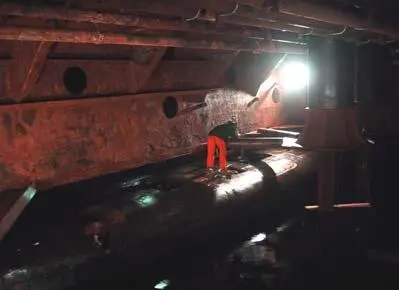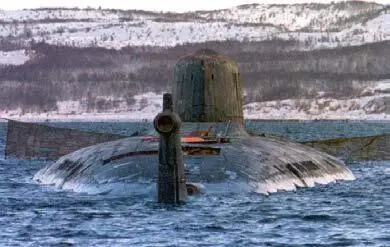• the discharged water contains fission and activation products released from fuel corroded for 14 months by seawater, as determined by a representative test, amounting to some 3×10 12Bq (Becquerel). Allowing for dilution in the sea, the total effective dose to a barge crewmember would be less than 1 μSv (at less than 0.1 μSievert/hour). Further development of this model analysis concluded that:
• a larger leak path would not significantly affect the above conclusion.
• if the same amount of fission and activation products were not discharged by the bubble expansion, but remained at the top of the reactor compartment, the 2m of seawater that will fill the space between the pressure hull and the casing would reduce the dose rate to a barge crew member to a few μSv/hour.
To mitigate these risks and those from uncontrolled criticality, discharge of radioactivity or direct radiation resulting in unacceptable levels of exposure, emergency arrangements to protect personnel, including evacuation by the RF Northern Fleet vessels and aircraft, were agreed with the RF Northern Fleet. These actions, triggered by an emergency reference level (ERL) protocol, applied to all personnel present on board M-S vessels.

Checking the sail for radioactivity. The sail (conning tower) of the Kursk protruding up into the cavity formed in the underside of the Giant 4
In completing its task, the Nuclear Coordinating Group adopted the following principles to ensure that the preparatory and recovery operations would not present an unacceptable nuclear or radiation risk to those involved with the recovery and, generally, to the marine environment (NCG 2001):
• Limits and Conditions:A clear set of limits and conditions had to be established for all of the operations to ensure that credible hazards would not challenge the capability of the structures, systems and components involved, both on the Kursk and or the Giant 4 .
• Degradation and Recovery Operations:The limits and conditions safeguarding the structures, systems and its components would have to account for damage sustained during the sinking, the degradation over the year on the sea bed, and for forces and circumstances introduced by the Mammoet-Smit recovery operations.
• Defense in Depth:There should be a number of separate safeguards in place at all times against all of the significant hazards.
• Tried & Tested Technology:Since the deployment of novel procedures and processes introduces additional risk, preferably tried and tested technology should applied.
• ALARP:the risk should be reduced to As Low As is Reasonably Practical.
• Radiological Management Regime:Radiation doses to those personnel involved in the recovery operation should be controlled below the limits for Class B radiation workers (as defined for the UK).
• In Contingency:Contingency plans should exist in the unlikely event of a significant radiological release, particularly for mitigating the impact upon the marine environment.
Mammoet-Smit had contracted to raise the Kursk in May 2001 and in just six short months, on 23 October, the Kursk was lowered from Giant 4 onto the cradles of the floating dry dock at Rosljakovo — a quite remarkable and World-first achievement.
The recovery of the Kursk was a success that derived from a tragedy. The successful and almost trouble free recovery of the sunken nuclear powered submarine Kursk was completed by a group of commercial organizations and not by its military operator. This was because the Russian Federation itself did not possess the resources and expertise to do this and, moreover, it had never planned to do so.

The wreck of the Kursk rising in the well of the floating dock at Rosljako
In planning and carrying through the entire recovery operation, the Dutch consortium Mammoet-Smit engaged quite remarkable levels of ingenuity of approach to this unique problem. Their strategy of building on their experience of their equipment and of salvage operations in general proved to be sound and ultimately successful.
Because there was insufficient time to generate and evaluate a conventional postincident nuclear safety case, members of the Nuclear Coordinating Group had to arrive at judgments drawn from their experience in nuclear safety, weaponry and engineering. Moreover, in doing so they had to cross the divide between East and West, accounting not just for the different approaches to nuclear and engineering technologies, but also how the safety reasoning of the original designs could be integrated into the salvage scheme.
This demanding and unique approach was shown to be sound because there was no radiological release or significant radiation hazard to any of the M-S personnel or contactors during any part of the recovery operations.
AMUNDSEN Ingar, et al, The Kursk Accident , Norwegian Radiation Protection Authority, Strålevern Rapport 2001:5
NUCLEAR COODINATING GROUP, 1st, 2nd and 3rd Stage Reports of the Nuclear Coordinating Group, Report Ref № R3065-1B/C/D, throughout 2001
PRINZ C. A., Kursk Submarine Sinking — An Assessment of Potential Hazards , Kursk Foundation, July 2001














